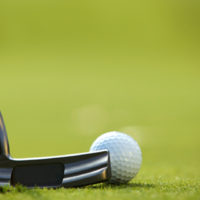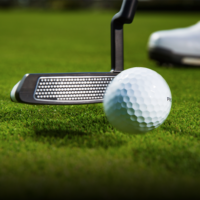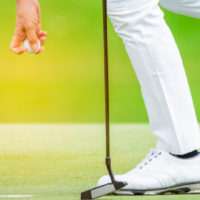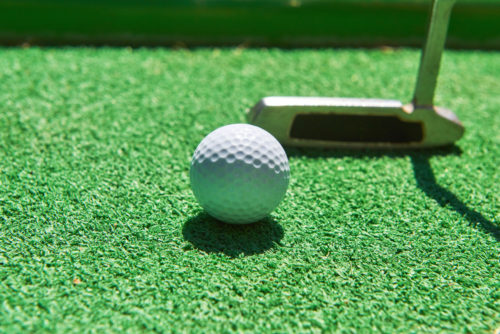Putters are a special class of clubs with a loft not exceeding ten degrees, designed primarily to roll the ball along the grass, generally from a point on the putting green toward the hole. Contrary to popular belief, putters do have a loft (often 5° from truly perpendicular at impact) that helps to lift the ball from any indentation it has made.
PUTTERS

Putters are a special class of clubs with a loft not exceeding ten degrees, designed primarily to roll the ball along the grass, generally from a point on the putting green toward the hole. Contrary to popular belief, putters do have a loft (often 5° from truly perpendicular at impact) that helps to lift the ball from any indentation it has made. Newer putters also include grooves on the face to promote roll rather than a skid off the impact. This increases rolling distance and reduces bouncing over the turf. Putters are the only class of club allowed to have certain features, such as two striking faces, non-circular grip cross-sections, bent shafts or hosels, and appendages designed primarily to aid players’ aim.

A putter is a club used in the sport of golf to make relatively short and low-speed strokes with the intention of rolling the ball into the hole from a short distance away. It is differentiated from the other clubs (typically, irons and woods) by a clubhead with a very flat, low-profile, low-loft striking face, and by other features which are only allowed on putters, such as bent shafts, non-circular grips, and positional guides.

Putters are generally used from very close distances to the cup, generally on the putting green, though certain courses have fringes and roughs near the green which are also suitable for putting. While no club in a player’s bag is absolutely indispensable nor required to be carried by strict rules, the putter comes closest. It is a highly specialized tool for a specific job, and virtually no golfer is without one.
Putting is the most precise aspect of the game of golf. The putter must be designed to give the golfer every technical advantage including smooth stroke, good glide, sweet impact, and bounce-less topspin ball launch as well as every technique advantage including perfect fit as to shaft angle and length.
The striking face of a putter is usually not perpendicular to the ground: putters have a small amount of loft, intended to “lift” the ball out of any depression it has made or settled into on the green, which reduces bouncing. This loft is typically 5–6°, and by strict rules cannot be more than 10°. The putter is the only club that may have a grip that is not perfectly round; “shield”-like cross-sections with a flat top and curved underside are most common. The putter is also the only club allowed to have a bent shaft; often, club-makers will attach the shaft to the club-head on the near edge for visibility, but to increase stability, the shaft is bent near the clubhead mounting so that its lie and the resulting clubhead position places the line of the straight part of the shaft at the sweet spot of the subhead, where the ball should be for the best putt. This increases accuracy as the golfer can direct their swing through the ball, without feeling like they are slightly behind it. Many putters also have an offset hosel, which places the shaft of the club in line with the center of the ball at impact, again to improve stability and feel as, combined with the vertical bend, the shaft will point directly into the center of the ball at impact.

Through attempts to lower the center of gravity of the club head, it evolved into a shorter, thicker head slightly curved from front to rear (the so-called “hot dog” putter). The introduction of investment casting for club heads allowed drastically different shapes to be made far more easily and cheaply than with forging, resulting in several design improvements. First of all, the majority of mass behind the clubface was placed as low as possible, resulting in an L-shaped side profile with a thin, flat club face and another thin block along the bottom of the club behind the face. Additionally, peripheral weighting, or the placing of mass as far away from the center of the clubface as possible, increases the moment of inertia of the club head, reducing twisting if the club contacts the ball slightly off-center and thus giving the club a larger “sweet spot” with which to contact the ball.
This increases accuracy as the golfer can direct their swing through the ball, without feeling like they are slightly behind it. Many putters also have an offset hosel, which places the shaft of the club in line with the center of the ball at impact, again to improve stability and feel as, combined with the vertical bend, the shaft will point directly into the center of the ball at impact.
Putting is the most precise aspect of the game of golf. The putter must be designed to give the golfer every technical advantage including smooth stroke, good glide, sweet impact, and bounce-less topspin ball launch as well as every technique advantage including perfect fit as to shaft angle and length.
The striking face of a putter is usually not perpendicular to the ground: putters have a small amount of loft, intended to “lift” the ball out of any depression it has made or settled into on the green, which reduces bouncing. This loft is typically 5–6°, and by strict rules cannot be more than 10°. The putter is the only club that may have a grip that is not perfectly round; “shield”-like cross-sections with a flat top and curved underside are most common.
The putter is also the only club allowed to have a bent shaft; often, club-makers will attach the shaft to the club-head on the near edge for visibility, but to increase stability, the shaft is bent near the clubhead mounting so that its lie and the resulting clubhead position places the line of the straight part of the shaft at the sweet spot of the subhead, where the ball should be for the best putt.
